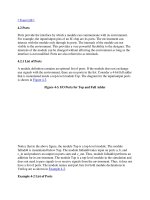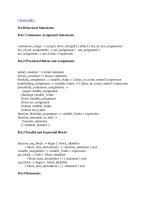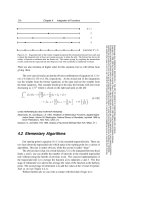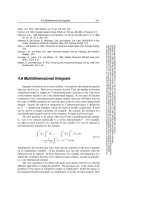Tài liệu Useful Modeling Techniques part 3 pptx
Bạn đang xem bản rút gọn của tài liệu. Xem và tải ngay bản đầy đủ của tài liệu tại đây (27.04 KB, 9 trang )
[ Team LiB ]
9.5 Useful System Tasks
In this section, we discuss the system tasks that are useful for a variety of purposes in
Verilog. We discuss system tasks
[1]
for file output, displaying hierarchy, strobing,
random number generation, memory initialization, and value change dump.
[1]
Other system tasks such as $signed and $unsigned used for sign conversion are not
discussed in this book. For details, please refer to the "IEEE Standard Verilog Hardware
Description Language" document.
9.5.1 File Output
Output from Verilog normally goes to the standard output and the file verilog.log. It is
possible to redirect the output of Verilog to a chosen file.
Opening a file
A file can be opened with the system task $fopen.
Usage: $fopen("<name_of_file>");
[2]
[2]
The "IEEE Standard Verilog Hardware Description Language" document provides
additional capabilities for $fopen. The $fopen syntax mentioned in this book is adequate
for most purposes. However, if you need additional capabilities, please refer to the "IEEE
Standard Verilog Hardware Description Language" document.
Usage: <file_handle> = $fopen("<name_of_file>");
The task $fopen returns a 32-bit value called a multichannel descriptor.
[3]
Only one bit is
set in a multichannel descriptor. The standard output has a multichannel descriptor with
the least significant bit (bit 0) set. Standard output is also called channel 0. The standard
output is always open. Each successive call to $fopen opens a new channel and returns a
32-bit descriptor with bit 1 set, bit 2 set, and so on, up to bit 30 set. Bit 31 is reserved.
The channel number corresponds to the individual bit set in the multichannel descriptor.
Example 9-9
illustrates the use of file descriptors.
[3]
The "IEEE Standard Verilog Hardware Description Language" document provides a
method for opening up to 2
30
files by using a single-channel file descriptor. Please refer
to it for details.
Example 9-9 File Descriptors
//Multichannel descriptor
integer handle1, handle2, handle3; //integers are 32-bit values
//standard output is open; descriptor = 32'h0000_0001 (bit 0 set)
initial
begin
handle1 = $fopen("file1.out"); //handle1 = 32'h0000_0002 (bit 1 set)
handle2 = $fopen("file2.out"); //handle2 = 32'h0000_0004 (bit 2 set)
handle3 = $fopen("file3.out"); //handle3 = 32'h0000_0008 (bit 3 set)
end
The advantage of multichannel descriptors is that it is possible to selectively write to
multiple files at the same time. This is explained below in greater detail.
Writing to files
The system tasks $fdisplay, $fmonitor, $fwrite, and $fstrobe are used to write to files.
[4]
N
ote that these tasks are similar in syntax to regular system tasks $display, $monitor, etc.,
but they provide the additional capability of writing to files.
[4]
The "IEEE Standard Verilog Hardware Description Language" document provides
many additional capabilities for file output. The file output system tasks mentioned in this
b
ook are adequate for most digital designers. However, if you need additional capabilities
for file output, please refer to the IEEE Standard Verilog Hardware Description
Language document.
Systems tasks for reading files are also provided by the IEEE Standard Verilog Hardware
Description Language. These system tasks include $fgetc, $ungetc, $fgetc, $fscanf,
$sscanf, $fread, $ftell, $fseek, $rewind, and $fflush. However, most digital designers do
not need these capabilities frequently. Therefore, they are not covered in this book. If you
need to use the file reading capabilities, please refer to the "IEEE Standard Verilog
Hardware Description Language" document.
We will consider only $fdisplay and $fmonitor tasks.
Usage: $fdisplay(<file_descriptor>, p1, p2 , pn);
$fmonitor(<file_descriptor>, p1, p2, , pn);
p1, p2, …, pn can be variables, signal names, or quoted strings.A file_descriptor is a
multichannel descriptor that can be a file handle or a bitwise combination of file handles.
Verilog will write the output to all files that have a 1 associated with them in the file
descriptor. We will use the file descriptors defined in Example 9-9
to illustrate the use of
the $fdisplay and $fmonitor tasks.
//All handles defined in Example 9-9
//Writing to files
integer desc1, desc2, desc3; //three file descriptors
initial
begin
desc1 = handle1 | 1; //bitwise or; desc1 = 32'h0000_0003
$fdisplay(desc1, "Display 1");//write to files file1.out & stdout
desc2 = handle2 | handle1; //desc2 = 32'h0000_0006
$fdisplay(desc2, "Display 2");//write to files file1.out & file2.out
desc3 = handle3 ; //desc3 = 32'h0000_0008
$fdisplay(desc3, "Display 3");//write to file file3.out only
end
Closing files
Files can be closed with the system task $fclose.
Usage: $fclose(<file_handle>);
//Closing Files
$fclose(handle1);
A file cannot be written to once it is closed. The corresponding bit in the multichannel
descriptor is set to 0. The next $fopen call can reuse the bit.
9.5.2 Displaying Hierarchy
Hierarchy at any level can be displayed by means of the %m option in any of the display
tasks, $display, $write task, $monitor, or $strobe task, as discussed briefly in Section 4.3
,
Hierarchical Names. This is a very useful option. For example, when multiple instances
of a module execute the same Verilog code, the %m option will distinguish from which
module instance the output is coming. No argument is needed for the %m option in the
display tasks. See Example 9-10
.
Example 9-10 Displaying Hierarchy
//Displaying hierarchy information
module M;
initial
$display("Displaying in %m");
endmodule
//instantiate module M
module top;
M m1();
M m2();
//Displaying hierarchy information
M m3();
endmodule
The output from the simulation will look like the following:
Displaying in top.m1
Displaying in top.m2
Displaying in top.m3
This feature can display full hierarchical names, including module instances, tasks,
functions, and named blocks.
9.5.3 Strobing
Strobing is done with the system task keyword $strobe. This task is very similar to the
$display task except for a slight difference. If many other statements are executed in the
same time unit as the $display task, the order in which the statements and the $display
task are executed is nondeterministic. If $strobe is used, it is always executed after all
other assignment statements in the same time unit have executed. Thus, $strobe provides
a synchronization mechanism to ensure that data is displayed only after all other
assignment statements, which change the data in that time step, have executed. See
Example 9-11
.
Example 9-11 Strobing
//Strobing
always @(posedge clock)
begin
a = b;
c = d;
end
always @(posedge clock)
$strobe("Displaying a = %b, c = %b", a, c); // display values at posedge
In Example 9-11
, the values at positive edge of clock will be displayed only after
statements a = b and c = d execute. If $display was used, $display might execute before
statements a = b and c = d, thus displaying different values.
9.5.4 Random Number Generation
Random number generation capabilities are required for generating a random set of test
vectors. Random testing is important because it often catches hidden bugs in the design.
Random vector generation is also used in performance analysis of chip architectures. The
system task $random is used for generating a random number.
Usage: $random;
$random(<seed>);
The value of <seed> is optional and is used to ensure the same random number sequence
each time the test is run. The <seed> parameter can either be a reg, integer, or time
variable. The task $random returns a 32-bit signed integer. All bits, bit-selects, or part-
selects of the 32-bit random number can be used (see Example 9-12
).
Example 9-12 Random Number Generation
//Generate random numbers and apply them to a simple ROM
module test;
integer r_seed;
reg [31:0] addr;//input to ROM
wire [31:0] data;//output from ROM
ROM rom1(data, addr);
initial
r_seed = 2; //arbitrarily define the seed as 2.
always @(posedge clock)
addr = $random(r_seed); //generates random numbers
<check output of ROM against expected results>
endmodule
The random number generator is able to generate signed integers. Therefore, depending
on the way the $random task is used, it can generate positive or negative integers.
Example 9-13
shows an example of such generation.
Example 9-13 Generation of Positive and Negative Numbers by $random Task
reg [23:0] rand1, rand2;
rand1 = $random % 60; //Generates a random number between -59 and 59
rand2 = {$random} % 60; //Addition of concatenation operator to
//$random generates a positive value between
//0 and 59.
N
ote that the algorithm used by $random is standardized. Therefore, the same simulation
test run on different simulators will generate consistent random
p
atterns for the same seed
value.
9.5.5 Initializing Memory from File
We discussed how to declare memories in Section 3.2.7
, Memories. Verilog provides a
very useful system task to initialize memories from a data file. Two tasks are provided to
read numbers in binary or hexadecimal format. Keywords $readmemb and $readmemh
are used to initialize memories.
Usage: $readmemb("<file_name>", <memory_name>);
$readmemb("<file_name>", <memory_name>, <start_addr>);
$readmemb("<file_name>", <memory_name>, <start_addr>,
<finish_addr>);
Identical syntax for $readmemh.
The <file_name> and <memory_name> are mandatory; <start_addr> and <finish_addr>
are optional. Defaults are start index of memory array for <start_addr> and end of the
data file or memory for <finish_addr>. Example 9-14
illustrates how memory is
initialized.
Example 9-14 Initializing Memory
module test;
reg [7:0] memory[0:7]; //declare an 8-byte memory
integer i;
initial
begin
//read memory file init.dat. address locations given in memory
$readmemb("init.dat", memory);
module test;
//display contents of initialized memory
for(i=0; i < 8; i = i + 1)
$display("Memory [%0d] = %b", i, memory[i]);
end
endmodule
The file init.dat contains the initialization data. Addresses are specified in the data file
with @<address>. Addresses are specified as hexadecimal numbers. Data is separated by
whitespaces. Data can contain x or z. Uninitialized locations default to x. A sample file,
init.dat, is shown below.
@002
11111111 01010101
00000000 10101010
@006
1111zzzz 00001111
When the test module is simulated, we will get the following output:
Memory [0] = xxxxxxxx
Memory [1] = xxxxxxxx
Memory [2] = 11111111
Memory [3] = 01010101
Memory [4] = 00000000
Memory [5] = 10101010
Memory [6] = 1111zzzz
Memory [7] = 00001111
9.5.6 Value Change Dump File
A value change dump (VCD) is an ASCII file that contains information about simulation
time, scope and signal definitions, and signal value changes in the simulation run. All
signals or a selected set of signals in a design can be written to a VCD file during
simulation. Postprocessing tools can take the VCD file as input and visually display
hierarchical information, signal values, and signal waveforms. Many postprocessing tools
as well as tools integrated into the simulator are now commercially available. For
simulation of large designs, designers dump selected signals to a VCD file and use a
postprocessing tool to debug, analyze, and verify the simulation output. The use of VCD
file in the debug process is shown in Figure 9-1
.
Figure 9-1. Debugging and Analysis of Simulation with VCD File
System tasks are provided for selecting module instances or module instance signals to
dump ($dumpvars), name of VCD file ($dumpfile), starting and stopping the dump
process ($dumpon, $dumpoff), and generating checkpoints ($dumpall). The uses of each
task are shown in Example 9-15
.
Example 9-15 VCD File System Tasks
//specify name of VCD file. Otherwise,default name is
//assigned by the simulator.
initial
$dumpfile("myfile.dmp"); //Simulation info dumped to myfile.dmp
//Dump signals in a module
initial
$dumpvars; //no arguments, dump all signals in the design
initial
$dumpvars(1, top); //dump variables in module instance top.
//Number 1 indicates levels of hierarchy. Dump one
//hierarchy level below top, i.e., dump variables in top,
//but not signals in modules instantiated by top.
initial
$dumpvars(2, top.m1);//dump up to 2 levels of hierarchy below top.m1
initial
$dumpvars(0, top.m1);//Number 0 means dump the entire hierarchy
// below top.m1
//Start and stop dump process
initial
begin
$dumpon; //start the dump process.
#100000 $dumpoff; //stop the dump process after 100,000 time units
end
//Create a checkpoint. Dump current value of all VCD variables
initial
$dumpall;
The $dumpfile and $dumpvars tasks are normally specified at the beginning of the
simulation. The $dumpon, $dumpoff, and $dumpall control the dump process during the
simulation.
[5]
[5]
Please refer to "IEEE Standard Verilog Hardware Description Language" document for
details on additional tasks such as $dumpports, $dumpportsoff, $dumpportson,
$dumpportsall, $dumpportslimit, and $dumpportsflush.
Postprocessing tools with graphical displays are commercially available and are now an
important part of the simulation and debug process. For large simulation runs, it is very
difficult for the designer to analyze the output from $display or $monitor statements. It is
more intuitive to analyze results from graphical waveforms. Formats other than VCD
have also emerged, but VCD still remains the popular dump format for Verilog
simulators.
However, it is important to note that VCD files can become very large (hundreds of
megabytes for large designs). It is important to selectively dump only those signals that
need to be examined.
[ Team LiB ]









